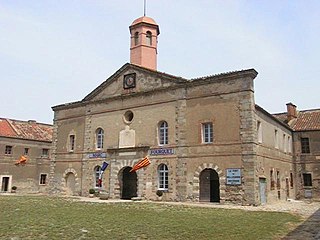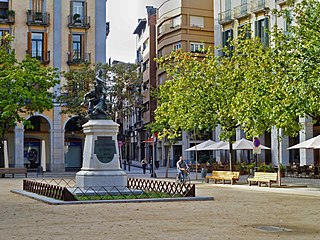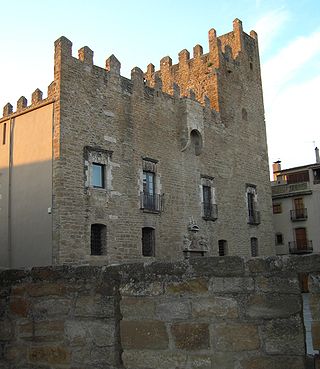
The Peninsular War (1807–1814) was the military conflict fought in the Iberian Peninsula by Spain, Portugal, and the United Kingdom against the invading and occupying forces of the First French Empire during the Napoleonic Wars. In Spain, it is considered to overlap with the Spanish War of Independence. The war started when the French and Spanish armies invaded and occupied Portugal in 1807 by transiting through Spain, and it escalated in 1808 after Napoleonic France occupied Spain, which had been its ally. Napoleon Bonaparte forced the abdications of Ferdinand VII and his father Charles IV and then installed his brother Joseph Bonaparte on the Spanish throne and promulgated the Bayonne Constitution. Most Spaniards rejected French rule and fought a bloody war to oust them. The war on the peninsula lasted until the Sixth Coalition defeated Napoleon in 1814, and is regarded as one of the first wars of national liberation. It is also significant for the emergence of large-scale guerrilla warfare.
The Battle of Valmaseda took place on 5 November 1808, during Lieutenant-General Blake's retreat from superior French armies in northern Spain. Reinforced by veteran regular infantry from General La Romana's Division of the North, Blake's force suddenly turned on its pursuers and ambushed General Victor's errant vanguard under Général de division Villatte.

The two battles of the Bruch were engagements fought successively, at El Bruc, near Barcelona, Catalonia, on 6 and 14 June 1808, during the Peninsular War, by French troops commanded by Brigadier General François de Schwarz and General of Division Joseph Chabran against Spanish volunteers and mercenaries led by General Antoni Franch i Estalella and Joan Baget.

The third siege of Girona occurred in northern Catalonia, Spain from 6 May to 12 December 1809, during the Napoleonic Wars. A significant event of the Peninsular War, France's Grande Armée lay siege to the town of Girona for seven months. Girona was strategically important because it controlled the main road between France and Spain.

The blockade of Barcelona, from August to December 1808, was the failed attempt by Spanish troops to recapture the French occupied Barcelona during the Peninsular War.

The siege of Bellegarde commenced on 23 May 1793 and ended on 24 June 1793 when Colonel Boisbrulé's French garrison surrendered the Fort de Bellegarde to a Spanish army under the command of Antonio Ricardos. The capture of the fort gave Spain control of an important road through the Pyrenees. The siege took place during the War of the Pyrenees, part of the French Revolutionary Wars. Fort de Bellegarde is on a height overlooking the border town of Le Perthus, which lies on the modern A9 autoroute and Autovía A-7.

Arthur Wellesley, 1st Duke of Wellington,, was one of the leading British military and political figures of the 19th century. Often referred to solely as "The Duke of Wellington", he led a successful military career in the Indian subcontinent during the Fourth Anglo-Mysore War (1798–99) and the Second Anglo-Maratha War (1803–1805), and in Europe during the Napoleonic Wars (1803–1815).

The Battle of Cardadeu on 16 December 1808 saw an Imperial French corps led by Laurent Gouvion Saint-Cyr assault a Spanish force commanded by Juan Miguel de Vives y Feliu and Theodor von Reding. Saint-Cyr won the engagement by forming most of his troops into gigantic attack columns and smashing through the Spanish lines. Cardedeu is located 17 kilometres (11 mi) northeast of Barcelona, Spain. The action occurred during the Peninsular War, part of the Napoleonic Wars.

The Battle of Girona on 20 and 21 June 1808 saw an Imperial French division led by Guillaume Philibert Duhesme try to overrun a Spanish garrison commanded by Lieutenant Colonels O'Donovan and O'Daly. The French assault failed and the attackers withdrew. Girona is located about halfway between the Franco-Spanish border and Barcelona on the Autovía A-7. The action occurred during the Peninsular War, part of the Napoleonic Wars.

The siege of Roses or Siege of Rosas from 7 November to 5 December 1808 saw an Imperial French corps led by Laurent Gouvion Saint-Cyr invest a Catalan and Spanish garrison commanded by Peter O'Daly. After a siege lasting a month in which the haven and town of Roses was captured and the nearby Trinity Castle invested by over 13,000 French and Italian infantry, artillery and cavalry with heavy siege trains on the hills above, the citadel was surrendered to the Napoleonic forces. Roses (Rosas) is located 43 kilometres (27 mi) northeast of Girona, Catalonia, Spain. The action occurred during the Peninsular War, part of the Napoleonic Wars.
Juan Miguel de Vives y Feliu, in Catalan: Joan Miquel Vives i Feliu, was a Spanish general.

The Battle of Molins de Rei or Battle of Molins de Rey or Battle of Molins del Rey saw an Imperial French corps led by Laurent Gouvion Saint-Cyr attack a Spanish army temporarily led by Theodor von Reding and the Conde de Caldagues because its commander Juan Miguel de Vives y Feliu was absent. Saint-Cyr outmaneuvered his opponents, distracting them with a false attack in front while sending the bulk of his force across Llobregat River in a turning movement around the Spanish right flank. The Spanish defensive lines crumbled and the French captured 1,200 soldiers, all the Spanish artillery and Caldagues himself. The Peninsular War engagement was fought near Molins de Rei, located 15 kilometres (9 mi) west of Barcelona, Catalonia, Spain.

In the Battle of La Bisbal on 14 September 1810 a Spanish division led by Henry O'Donnell and supported by an Anglo-Spanish naval squadron led by Francis William Fane and Charles William Doyle surprised an Imperial French brigade commanded by François Xavier de Schwarz. The Imperial troops were from the Confederation of the Rhine, a collection of small German states that were allied to Napoleon. Part of a division led by Marie François Rouyer, Schwarz's brigade was almost completely wiped out, most of its soldiers being taken prisoner along with its commander. One of the few Allied casualties was the capable O'Donnell, wounded in the foot. The battle occurred during the Peninsular War, part of the Napoleonic Wars.

The siege of Figueras, which lasted from 10 April to 19 August 1811, saw the Spanish garrison of Sant Ferran Castle led by Brigadier General Juan Antonio Martínez defend against an Imperial French force commanded by Marshal Jacques MacDonald and his deputy Louis Baraguey d'Hilliers. Martínez and his men held out much longer than expected but were eventually starved into surrendering the fortress, which was near Figueres. The action occurred during the Peninsular War, part of the Napoleonic Wars.

The Spanish Army of the Peninsular War refers to the Spanish military units that fought against France's Grande Armée during a period which coincided with what is also termed the Spanish War of Independence.

The Cardedeu order of battle lists the troops that fought in the Battle of Cardedeu and several other battles fought between June and December in the Spanish province of Catalonia during the Peninsular War. In February 1808, Imperial French forces treacherously seized Barcelona on 29 February and Sant Ferran Castle on 15 March as well as other fortresses in Spain. The Dos de Mayo Uprising broke out when the Spanish people found that Emperor Napoleon deposed the Spanish royal family and set up his brother Joseph Bonaparte as their new king. The 12,000 Imperial French soldiers under Guillaume Philibert Duhesme occupying Catalonia were beaten at the Battles of El Bruch and Gerona in June. Though Duhesme was reinforced by another French division, the Spanish defeated him at the Second Siege of Gerona in July and August. With Duhesme blockaded in Barcelona, Napoleon appointed Laurent Gouvion Saint-Cyr as commander of the VII Corps, added two good divisions and other troops to his force, and ordered him to relieve Barcelona. Saint-Cyr succeeded in this task, winning the battles of Roses, Cardedeu and Molins de Rei in December.

The 1st Regiment of the Line (King's Own) or (Italian: 1° Reggimento della Linea 'del Re') was a line infantry regiment of the Royal Army of Naples. The regiment was the first infantry regiment formed by the small kingdom, but by 1811 gained a reputation as an exemplary infantry regiment, and was reformed with the honorary title of "King's Own, or del Re". After the disastrous Neapolitan War, the regiment was disbanded, having never seen action outside of the Napoleonic Wars.
Juan de la Cruz Baget y Pamiés was a lawyer and commanding officer of the Catalonian somatenes and miqueletes during the Peninsular War.
Raimundo Caldagues y Remond, Count of Caldagues was a French military commander of the Spanish army who distinguished himself leading the relief force at the second siege of Girona. He was promoted to field marshal the following day.
Jaime García Conde (1767–1820) was a Spanish military commander.















